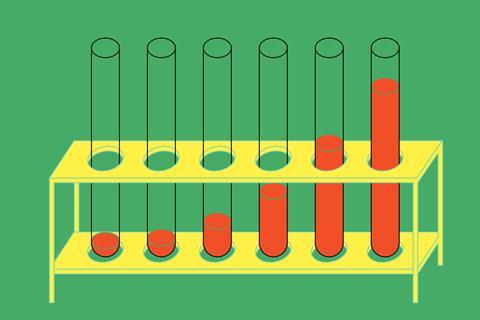Students are more successful if they view graphs as a distribution rather than a process

Interpreting graphs is an important skill for chemistry students. Graphs that show a distribution of states, such as the Maxwell—Boltzmann (MB) distribution, are particularly difficult. Students studying chemistry at a higher level encounter more complex examples when they learn about probability distributions in quantum mechanics. It is crucial they understand what is required to read them.
In a recent study, Jon-Marc Rodriguez’ research team probed students’ abilities to explain the MB distribution and make predictions based on their understanding. The authors note a recent shift in chemistry education research away from cataloguing students’ misconceptions to characterising the reasoning behind those misconceptions, with a view to helping students make more effective use of their existing knowledge. This informed their research methodology, which explored the knowledge students used to engage with the MB distribution.
The research team interviewed 12 undergraduate students at a US college. They asked the students to describe and sketch what happens in a sealed flask of neon at room temperature, and then when it is heated to 100°C. The researchers then prompted students to describe what a MB distribution curve showed, and asked them to sketch the curve at a higher temperature. Finally, they showed the students a distribution graph with two curves depicting different temperatures and asked them to explain which curve corresponded to the higher temperature, and the faster reaction.
The researchers analysed the specific features of the graphs and prompts the students attended to, and the knowledge students used. They noted times when certain pieces of knowledge activated other ideas, and identified fragmented knowledge by the absence of such links. From this, they created ‘resource graphs’ – maps of each student’s knowledge. The analysis also identified inferences students were able to make successfully based on their engagement with the questions.
The findings show that students are more able to make inferences if they view the MB graph as a distribution rather than as a process. Students who view it as a process assume covariation between quantities on the axes. For example, they may assume that as speed increases, the number of molecules decreases. This leads to faulty knowledge application when responding to questions. Additionally, students need to read the peak as an indication of particles grouping, rather than as an event, in order to apply other ideas.
Teaching tips
- Support students to recognise that distribution graphs must be interpreted differently to other graphs – there is no covariation between x and y.
- Emphasise links to principles covered in mathematics. Some of the successful students in this study referred to histograms and ‘normal’ curves.
- Explicitly communicate to students the variation in a system with respect to parameters like kinetic energy and speed. While it is an implicit assumption for experts, it is not for students, and they need to know this in order to connect it to the appearance of a distribution curve.
- Try this online simulation. It plots the MB distribution as a histogram alongside a dynamic animation depicting particle motion. Colour-coding differentiates kinetic energies.
- Choose appropriate assessment questions. It is crucial to expose and help correct faulty knowledge application. Try providing sample answers for students to critique, for example: ‘It appears that as the speed increases there are more collisions, meaning there are more reactions that reduce the number of molecules’.
- Use the ‘resource graphs’ illustrating students’ knowledge frameworks from this study to help you uncover the origins of your students’ misconceptions. The graphs also show the value of speaking to students in depth about their understanding of challenging concepts.
Teaching tips
- Support students to recognise that distribution graphs must be interpreted differently to other graphs – there is no covariation between x and y.
- Emphasise links to principles covered in mathematics. Some of the successful students in this study referred to histograms and ‘normal’ curves.
- Explicitly communicate to students the variation in a system with respect to parameters like kinetic energy and speed. While it is an implicit assumption for experts, it is not for students, and they need to know this in order to connect it to the appearance of a distribution curve.
- Try this online simulation: bit.ly/2V4Rsuq. It plots the MB distribution as a histogram alongside a dynamic animation depicting particle motion. Colour-coding differentiates kinetic energies.
- Choose appropriate assessment questions. It is crucial to expose and help correct faulty knowledge application. Try providing sample answers for students to critique, for example: ‘It appears that as the speed increases there are more collisions, meaning there are more reactions that reduce the number of molecules’.
- Use the ‘resource graphs’ illustrating students’ knowledge frameworks from this study to help you uncover the origins of your students’ misconceptions. The graphs also show the value of speaking to students in depth about their understanding of challenging concepts.
References
J-M G Rodriguez, A R Stricker and N M Becker, Chem. Educ. Res. Pract., 2020, 21, 536 (DOI: 10.1039/c9rp00249a)









No comments yet